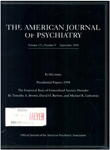The phenomenological and conceptual interface between borderline personality disorder and PTSD
Abstract
OBJECTIVE: The authors explore the conceptual and phenomenological interface between posttraumatic stress disorder (PTSD) and borderline personality disorder as well as the therapeutic and research implications of this interface. METHOD: They systematically review the relevant empirical, conceptual, and clinical literature. RESULTS: These seemingly separate disorders are related. Borderline personality disorder is often shaped in part by trauma, and individuals with borderline disorder are therefore vulnerable to developing PTSD. CONCLUSIONS: The authors draw a distinction between the enduring effects that traumas can have on formation (or change) of axis II personality traits (including those found in borderline personality disorder) and acute symptomatic reactions to trauma, called PTSD, that are accompanied by specific psychophysiological correlates. They describe the implications of these conclusions for DSM-IV, therapy, and future research.
Access content
To read the fulltext, please use one of the options below to sign in or purchase access.- Personal login
- Institutional Login
- Sign in via OpenAthens
- Register for access
-
Please login/register if you wish to pair your device and check access availability.
Not a subscriber?
PsychiatryOnline subscription options offer access to the DSM-5 library, books, journals, CME, and patient resources. This all-in-one virtual library provides psychiatrists and mental health professionals with key resources for diagnosis, treatment, research, and professional development.
Need more help? PsychiatryOnline Customer Service may be reached by emailing [email protected] or by calling 800-368-5777 (in the U.S.) or 703-907-7322 (outside the U.S.).



